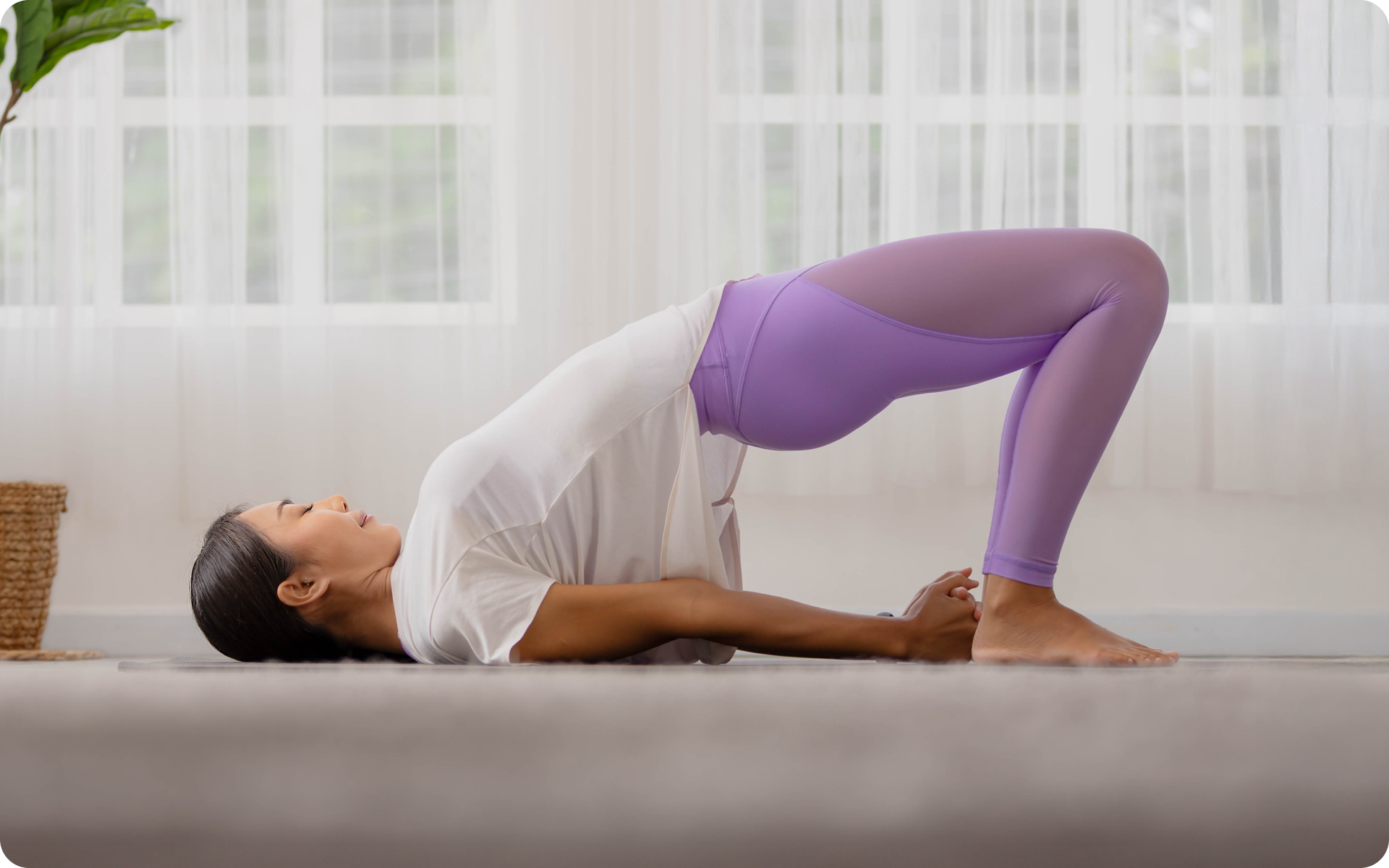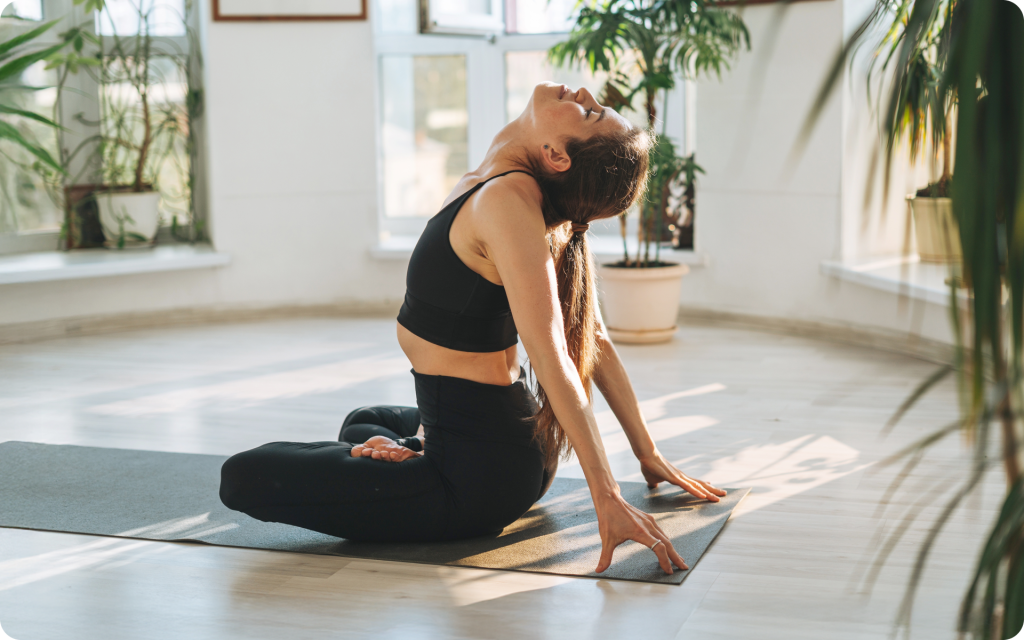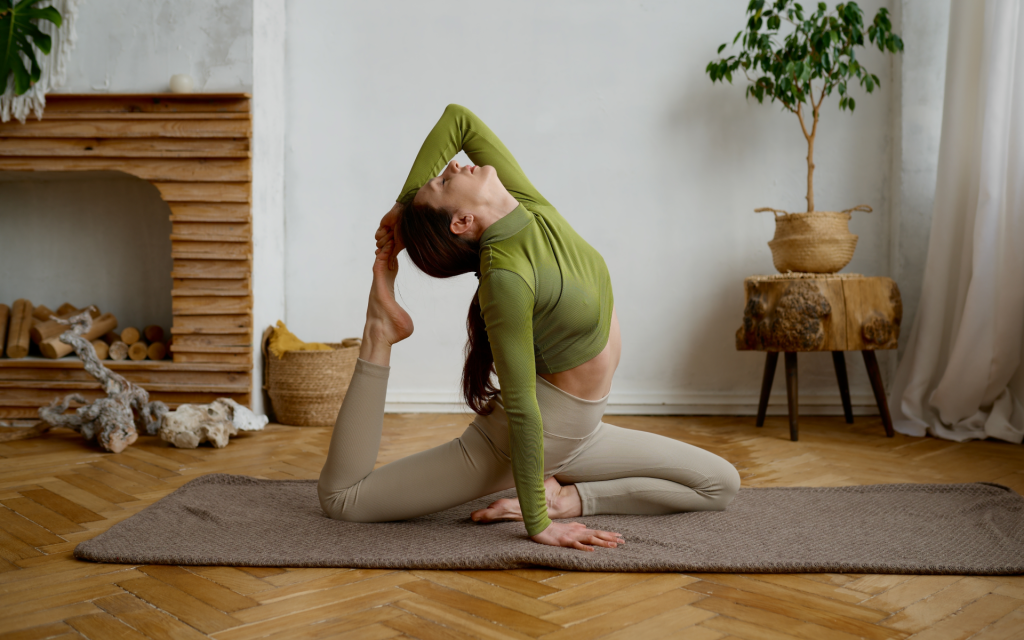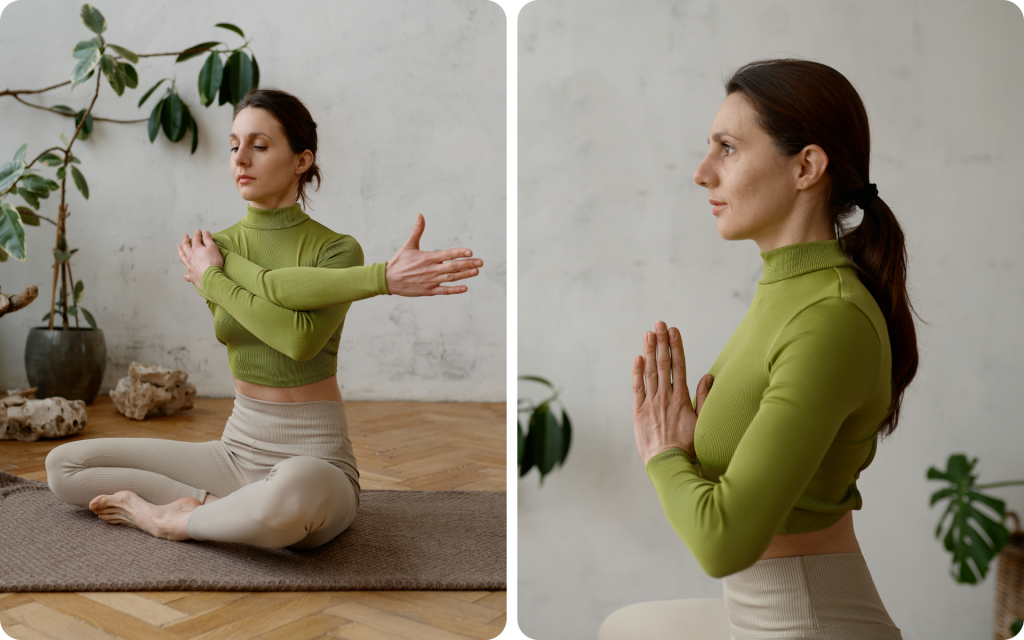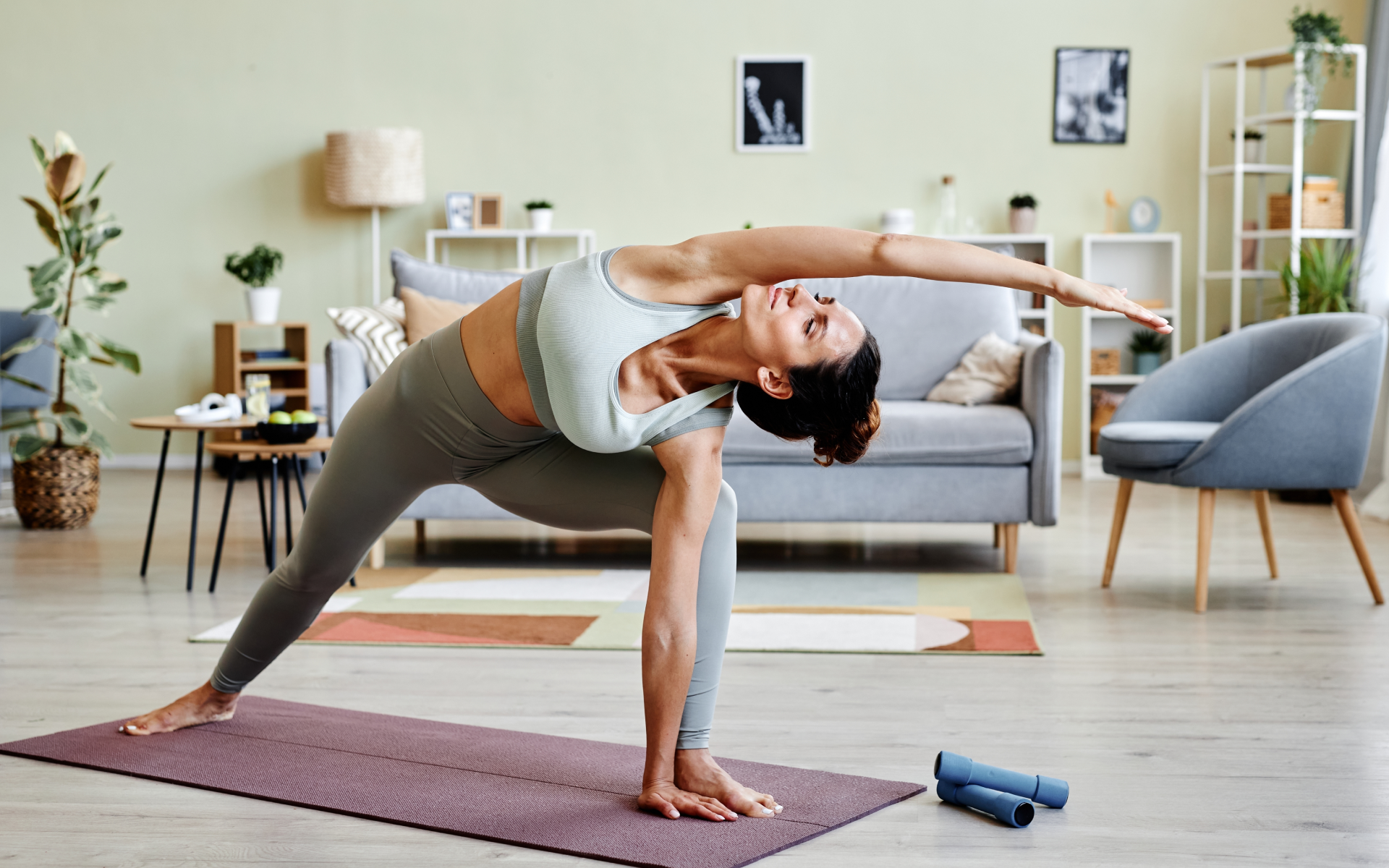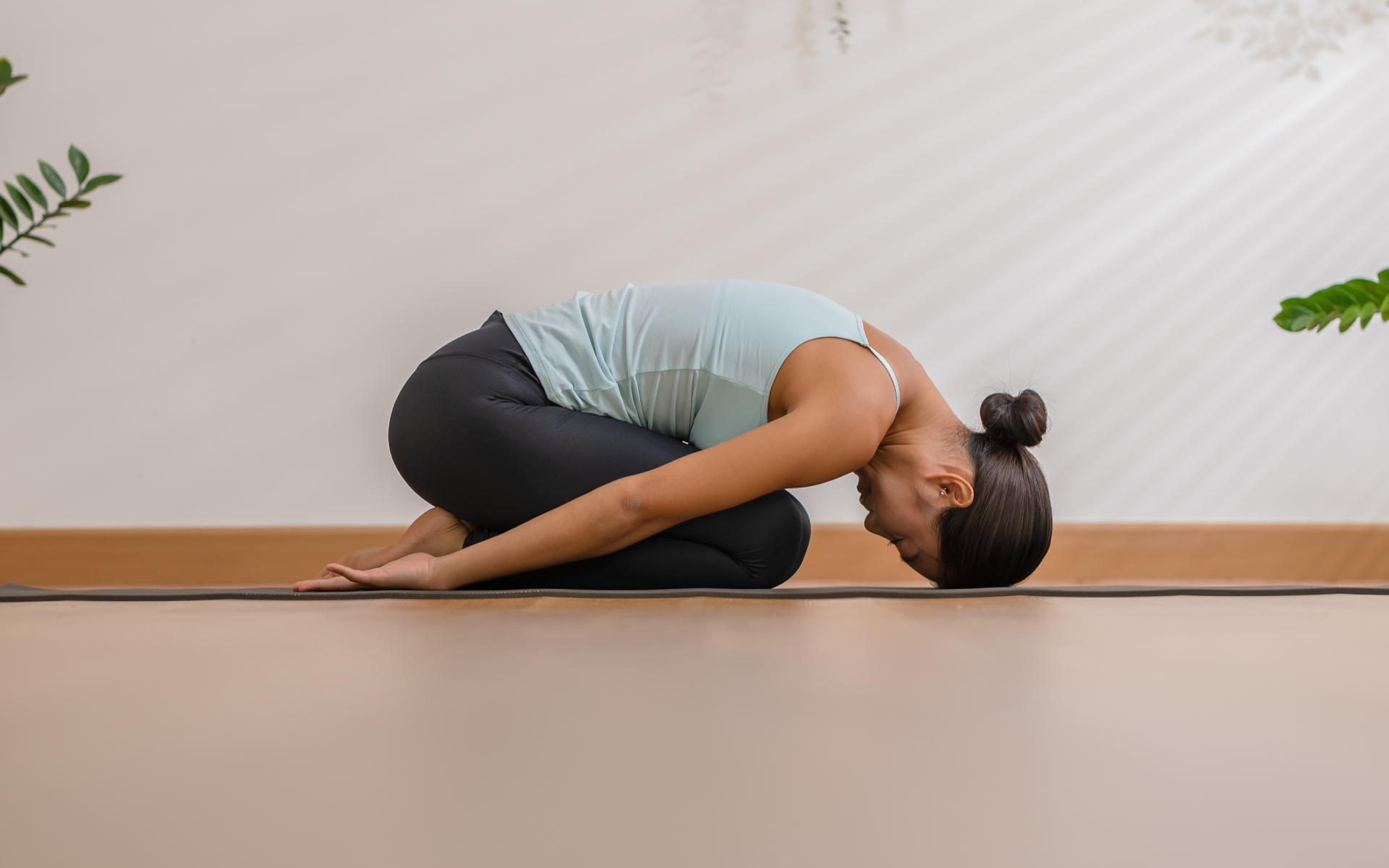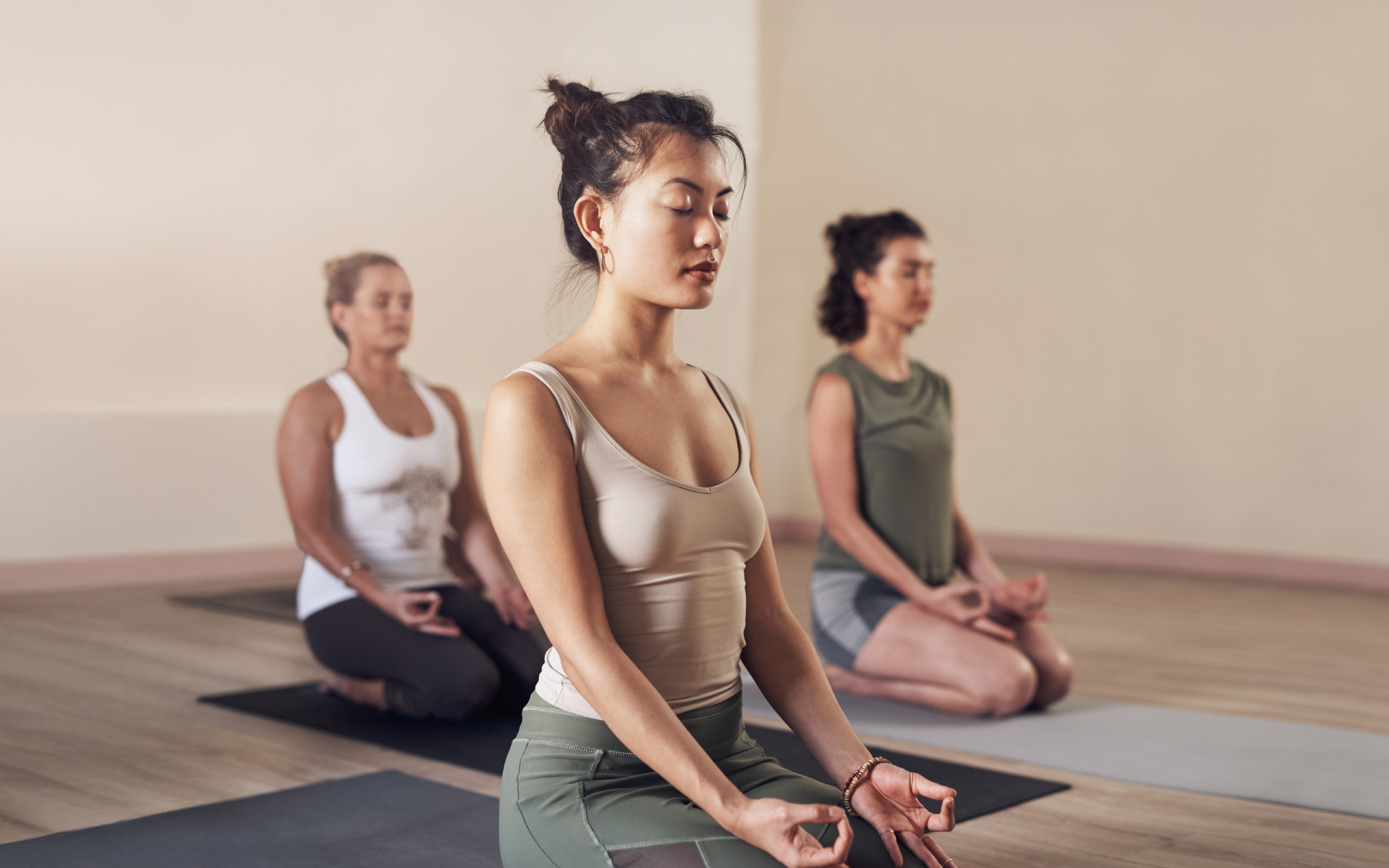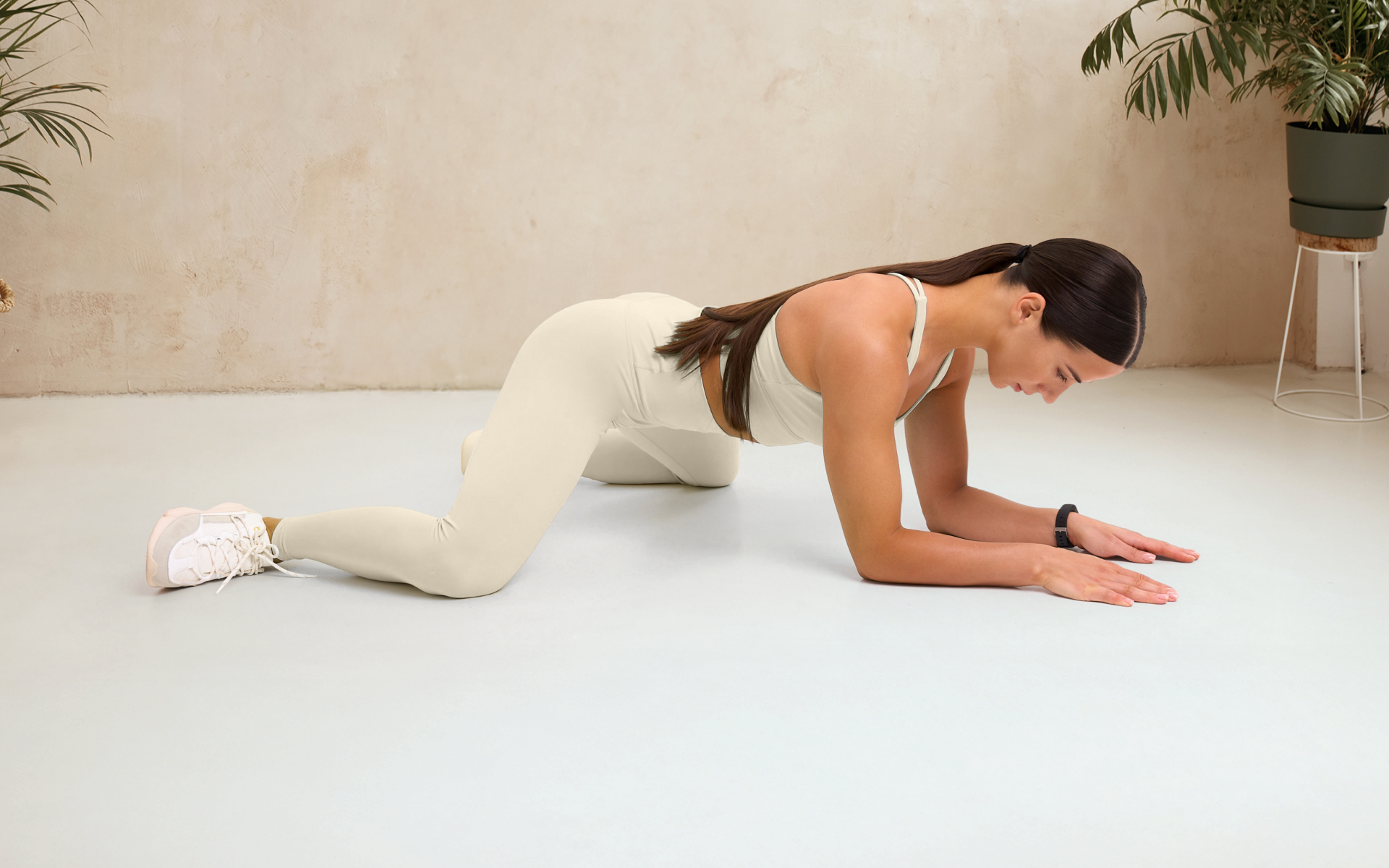Stress and poor sleep can feel like a vicious cycle. When stress levels rise, sleep often becomes elusive, and without restful sleep, stress builds even further. But what if the answer to breaking this pattern lies in how you move your body?
Clinical somatic education (CSE) may offer a solution. This approach uses guided somatic exercise – gentle, mindful movements to recalibrate habitual muscular patterns (1).
Unlike stretching or traditional fitness exercises, guided somatic exercises are about learning, not effort. They guide you to explore and reconnect with your body, promoting relaxation and functional ease. These exercises can be practiced in private sessions, group classes, or at home.
In this article, we’ll explore six guided somatic exercises that may support stress relief and lead to more restful sleep.
How Do Guided Somatic Exercises Work?
Guided somatic exercises are about actively retraining the way your body moves and holds tension. They rely on deliberate, slow, and conscious movements to help your nervous system “unlearn” deeply ingrained muscular habits that often lead to pain and stiffness (2).
Unlike approaches that passively stretch or manipulate the body, these exercises actively engage your brain to create new, healthier movement patterns.
The guidance aspect of somatic exercises makes them unique and effective. Initially, a certified somatic educator may lead you through private lessons or group classes. During these sessions, you’ll learn to gently explore your body’s sensations and movements. The goal is to increase awareness of where you hold tension and how you can release it.
Private lessons provide hands-on guidance tailored to your needs. The educator may use touch and verbal instructions to help you feel subtle changes in your muscles and movement pathways.
On the other hand, group classes rely on verbal cues. These sessions emphasize internalizing the movements without mimicking someone else, encouraging a deeper, individualized understanding.
Many people also practice somatic exercises independently at home using online resources. Home practice requires commitment and focus, but allows you to apply what you’ve learned at your own pace.
Regardless of the setting, the process is always centered on exploring your sensations, training your nervous system, and gradually restoring natural, efficient movement.
This guided, exploratory approach empowers you to take control of your physical well-being, fostering lasting improvements in posture, flexibility, and pain relief.
Read more: Somatic Stretching Exercises: Benefits, Tips, and How to Get Started
Who Can Benefit from Guided Somatic Exercises?
Anyone who wants greater control over how their body feels and moves can benefit from guided somatic exercises. Some common use cases of this practice include:
Those with Chronic Pain or Muscle Tension
CSE is often beneficial for individuals dealing with long-term pain or tightness. These issues frequently stem from learned muscular patterns, which can lead to improper movement and constant strain. Guided somatic exercises aim to retrain the nervous system, which helps release these patterns and restore ease of movement (3).
- Chronic neck, back, or shoulder pain sufferers
- Individuals with tension headaches or TMJ disorders
- Those recovering from repetitive strain injuries
BetterMe: Health Coaching app helps you achieve your body goals with ease and efficiency by helping to choose proper meal plans and effective workouts. Start using our app and you will see good results in a short time.
People Experiencing Stress-Related Tension
The body holds onto stress, creating tension in muscles that can feel impossible to release (4). Guided somatic exercises use slow, conscious movements to help calm the nervous system and reduce stress-related tightness (5). They can be of help to:
- Individuals who are experiencing frequent physical symptoms of stress
- People who are struggling with poor posture due to stress habits
- Professionals in high-pressure jobs who are looking for physical and mental relaxation
Athletes Who Are Looking to Enhance Performance
Athletes often benefit from improved movement efficiency and muscle control. Somatic exercises can refine how the body moves, improve recovery, and even minimize the risk of injury by addressing imbalances (6).
- Runners who want to reduce repetitive overloading patterns
- Dancers and yogis who are looking for greater body awareness
- Weightlifters or other athletes who are managing pre-existing tension
Older Adults Who Want to Maintain Mobility
Age-related changes in posture and flexibility can often lead to discomfort or difficulty with daily tasks (7). Guided somatic exercises are gentle enough for older individuals and can help them maintain independence in movement (8).
- Seniors who are facing stiffness or reduced range of motion
- Those who are dealing with common age-related postural issues
- Individuals who want to prevent falls or injuries
Individuals Who Lead Sedentary Lifestyles
Prolonged periods of sitting or inactive days can lead to tight, shortened muscles and poor alignment (9). Guided somatic exercises help counter these imbalances (10).
- Office workers who spend hours at a desk
- Drivers or others who sit for extended periods
- Anyone who is looking to regain comfort in everyday activities
Do You Need a Therapist for Guided Somatic Exercises?
Working with a certified somatics educator can be a deeply enriching experience. These professionals are trained to guide you through exploratory movements and help you identify patterns unique to your body. They offer personalized attention, which creates an environment where you feel supported as you learn.
Through verbal cues and tailored exercises, an educator can help you better understand and refine your internal awareness, which makes it easier to reconnect with more natural, comfortable movement patterns.
That being said, not everyone has access to in-person sessions, and that’s okay.
Practicing alone with online resources is a great alternative, especially for those who live far from an educator. Online courses provide detailed instructions and the flexibility to learn at your own pace.
While it may require more self-discipline, many people experience excellent results with this approach. To succeed, you need a quiet, distraction-free space and an internal focus on what you’re feeling during the movements.
Although both options are valuable, access to an educator provides a more tailored learning experience. If in-person guidance isn’t possible, online practice can still serve as an effective path to better movement and well-being.
Our previous post goes into great detail how to lead a guided meditation.
How Often Should You Do Guided Somatic Exercises?
If your schedule allows, the daily practice of guided somatic exercises would provide the most benefits. Every day, your body accumulates tension from activities, stress, or poor posture.
A daily somatic practice releases this tension before it becomes chronic. It also reinforces the process of retraining your nervous system, making sustained progress possible. Think of it as maintaining the balance between tension release and muscle re-education (11). If you’re curious about 12 guided somatic experiencing exercises, check out our earlier article.
Timing That Works for You
The beauty of somatics lies in its flexibility. You can practice any time of day that suits your schedule and your body’s needs.
- After a workout is an ideal time for many people. The exercises serve as a cool-down, releasing tension and reducing soreness.
- If mornings are when you feel stiff or achy, start your day with a short session to loosen up.
- Evening sessions help unwind from daily stress and prepare for restful sleep.
Choose a time that makes the practice sustainable for you – consistency is what matters most.
Make It Manageable
Start small. If you’re new to somatics, 10-15 minutes a day is enough to build the habit. With time, you’ll naturally want to practice longer as you experience the benefits. Many people settle into 30-minute sessions, but even short daily practices make a difference.
If your life feels busy, fit somatic exercises into your routine in small ways. A few mindful minutes can still release tension and keep your body on track.
Don’t think of these exercises like a prescription (do this specific exercise for this amount of time), but rather as an exploration. Feel your way through the exercises and adjust accordingly. Compare how you feel before and after, and take note of what works best for you.
What Are Some Common Guided Somatic Exercises?
Below are six commonly practiced guided somatics exercises.
While these exercises are commonly practiced in clinical somatics, the best results come from exploring them with mindfulness and adapting to your unique needs. Pay close attention to how your muscles feel during and after the exercises, and practice regularly to support your body’s natural tension release and realignment processes.
Arch and Flatten
The arch and flatten exercise focuses on mobilizing the pelvis and lumbar spine, releasing tension in the lower back and hip flexor muscles (12). It also helps restore balance between the front and back of the body, which improves posture and core stability.
Steps to Perform
- Lie on your back with your knees bent and your feet flat on the floor, approximately hip-width apart.
- Rest your arms comfortably at your sides with your palms facing up.
- Gently inhale and arch your lower back away from the floor. Feel your spine lifting and your pelvis tilting forward.
- Exhale slowly as you press your lower back into the floor. Allow your pelvis to tilt backward, feeling your abdominal muscles engage.
- Continue this slow, mindful movement for 6-8 repetitions, focusing on releasing tension with each breath and movement.
Arch and Curl
Arch and curl helps release tension in the abdominal muscles and lengthen the front of the body. It encourages awareness of spinal alignment while building strength in the core (13).
Steps to Perform
- Lie on your back with your knees bent, your feet flat on the floor, and your arms resting at your sides.
- Begin with the arch and flatten motion, inhaling as you arch your lower back.
- From the arched position, exhale deeply and curl your upper body off the floor, bringing your ribs toward your pelvis. Imagine folding through the center of your body.
- On the next inhale, gently lower your body back to the arched position.
- Repeat this sequence 6-8 times, paying attention to the smooth transition between arching and curling.
Side Curl
The side curl targets the oblique muscles and the sides of the torso. It improves lateral flexibility and helps to release tension in the ribcage and waist area (14).
Steps to Perform
- Lie on your back with your knees bent and your feet flat on the floor.
- Rest one arm overhead and the other alongside your body.
- Slowly inhale as you arch your lower back and shift your ribs gently toward the arm that is extended overhead, creating a slight side stretch.
- Exhale and curl your side toward the opposite hip, contracting the side torso muscles. Allow your head and shoulder to lift slightly.
- Return to the neutral position and repeat 6-8 times on one side before switching to the other.
Back Lift
The back lift is designed to target the extensors of the spine and shoulders. It helps release tension in the upper back, shoulders, and neck while improving posture and spinal mobility (15).
Steps to Perform
- Lie face down, resting your forehead on your hands with your elbows bent outward.
- Relax your legs and pelvis, allowing them to settle into the floor.
- Gently inhale as you lift your head, shoulders, and arms slightly off the floor, engaging the muscles along your back.
- Exhale as you slowly return to the starting position, releasing tension and relaxing fully.
- Perform 6-8 repetitions, using slow and controlled movements to deepen your awareness of the back muscles.
Washcloth
The washcloth exercise addresses rotational patterns in the torso and spine, releasing tension in the shoulders, chest, and back. It enhances your body’s natural spinal rotation (16).
Steps to Perform
- Lie on your back with your knees bent and your feet flat on the floor.
- Cross your arms over your chest, placing your hands on opposite shoulders.
- Gently inhale and allow your knees to drop to one side while turning your head in the opposite direction. Rotate your torso slightly while keeping your shoulders grounded.
- Exhale and return to the center, feeling your muscles release.
- Repeat on the other side, alternating for 6-8 repetitions with smooth, flowing movements.
BetterMe will shake off your mental funk, rid you of your energy-zapping habits, and help you sculpt the body of your dreams. Intrigued? Hurry up and change your life for the better!
Pelvic Clock
The pelvic clock targets the alignment and mobility of the pelvis. It helps release tension in the hips, lower back, and surrounding areas, which improves coordination and pelvic control (17).
Steps to Perform
- Lie on your back with your knees bent, your feet flat on the floor, and your arms resting at your sides.
- Visualize the face of a clock on your pelvis. Slowly tilt your pelvis to move from 12 o’clock (toward your head) to 6 o’clock (toward your feet).
- Gradually explore other “times” on the clock, shifting the pelvis side-to-side and diagonally.
- Move through the clock in a circular motion, changing directions after a few rounds.
- Practice for 2-3 minutes, focusing on smooth movements and releasing tension around your hips and lower back.
Read more: Does Somatic Yoga Really Work? Here’s What You Need to Know
How Are Guided Somatic Exercises Different from Regular Stretches?
- Active Engagement vs. Passive Stretching
Guided somatic exercises actively engage the nervous system, teaching it to release chronic muscular tension and relearn efficient movement patterns (2). In contrast, regular stretching is often passive and focuses on enhancing flexibility without much awareness of internal sensation (18).
- The Stretch Reflex and Lasting Results
Regular stretching can trigger the stretch reflex (myotatic reflex), where muscles contract to protect themselves from overstretching. This limits the effectiveness of static stretching and often results in short-lived benefits (19).
Somatic exercises avoid this reflex by using slow, controlled movements that gently contract and release muscles, which leads to lasting changes (19).
- Retraining Movement Patterns
Somatic exercises focus on retraining full-body movement patterns, addressing the root causes of tension and misalignment. Regular stretches typically stretch already overstretched muscles, which may not resolve the underlying issues contributing to chronic pain or poor posture (20).
- Individualized Approach
Everyone’s muscular patterns are unique, and somatic exercises are designed to adapt to these individual differences. They encourage exploration and awareness, allowing each person to discover what works best for their body.
- Long-Term Benefits
Somatic exercises create lasting improvements in muscle function, posture, and movement by enhancing bodily awareness and parasympathetic nervous system activation (21). While it’s beneficial for temporary relief, regular stretching doesn’t typically lead to long-term changes in muscle memory or movement efficiency (20).
- A Holistic Practice
Somatic exercises integrate mindfulness and body awareness, potentially fostering a deeper connection between the mind and body. This holistic approach enhances overall well-being, which makes it more than just a physical practice. Regular stretching, while helpful for flexibility, often lacks this integrative focus (19).
Yes, guided somatic exercises are safe for most people when they’re performed mindfully. The movements are slow, gentle, and suitable for all ages and abilities. They work with the nervous system to release tension without overstretching or straining muscles, which minimizes the risk of injury. Yes, guided somatic exercises are highly effective for relieving stress (22). By focusing on slow, mindful movements, they activate the parasympathetic nervous system, which promotes relaxation and reduces the physical and mental effects of stress. Yes, guided somatic exercises can improve sleep by releasing accumulated muscular tension and calming the nervous system. The relaxation and body awareness they encourage help the mind and body transition into a restful state, which supports better sleep quality (23). For more details about somatic breathing exercises, take a look at our prior publication. Yes, guided somatic exercises are designed to be easy and adaptable. They involve small, gentle movements and focus on listening to your body’s needs. With practice, they can become intuitive and accessible to most people, regardless of their experience or fitness level.Frequently Asked Questions
Are guided somatic exercises safe?
Do guided somatic exercises help with stress?
Can guided somatic exercises improve sleep?
Are guided somatic exercises easy?
The Bottom Line
Guided somatic exercises offer a gentle, effective approach to releasing muscular tension, improving movement patterns, and fostering a deeper mind-body connection. Their adaptability makes them accessible to individuals of all ages and fitness levels, while their benefits extend to stress relief, improved sleep, and enhanced overall well-being. Incorporating these into your daily routine can transform how you feel in both your body and mind.
DISCLAIMER:
This article is intended for general informational purposes only and does not serve to address individual circumstances. It is not a substitute for professional advice or help and should not be relied on for making any kind of decision-making. Any action taken as a direct or indirect result of the information in this article is entirely at your own risk and is your sole responsibility.
BetterMe, its content staff, and its medical advisors accept no responsibility for inaccuracies, errors, misstatements, inconsistencies, or omissions and specifically disclaim any liability, loss or risk, personal, professional or otherwise, which may be incurred as a consequence, directly or indirectly, of the use and/or application of any content.
You should always seek the advice of your physician or other qualified health provider with any questions you may have regarding a medical condition or your specific situation. Never disregard professional medical advice or delay seeking it because of BetterMe content. If you suspect or think you may have a medical emergency, call your doctor.
SOURCES:
- What is Clinical Somatic Education? (n.d., somaticmovementcenter.com)
- Somatic Exercise: A Guide to Restoring Body Awareness (2024, news-medical.net)
- Moving With Pain: What Principles From Somatic Practices Can Offer to People Living With Chronic Pain (2021, frontiersin.org)
- Stress effects on the body (2018, apa.org)
- Unlocking Your Body: Your Personal Process of Releasing Tension and Pain (2019, somaticmovementcenter.com)
- What conditions can Somatics help? (2018, somaticmovementcenter.com)
- Ageing Process and Physiological Changes (2016, intechopen.com)
- Somatic movement intervention among older adults to improve body awareness and spine mobility: A pilot study (2025, sciencedirect.com)
- Sitting for Too Long, Moving Too Little: Regular Muscle Contractions Can Reduce Muscle Stiffness During Prolonged Periods of Chair-Sitting (2021, frontiersin.org)
- How to Even out the Imbalances in Your Body (2019, somaticmovementcenter.com)
- Unlocking Your Body: Your Personal Process of Releasing Tension and Pain (2019, somaticmovementcenter.com)
- Back Pain Exercise (n.d., somaticmovementcenter.com)
- Arch & Curl (2019, somaticmovementcenter.com)
- Side Curl (2019, somaticmovementcenter.com)
- Back Lift (2019, somaticmovementcenter.com)
- Washcloth (2019, somaticmovementcenter.com)
- Pelvic Clock (2019, somaticmovementcenter.com)
- CURRENT CONCEPTS IN MUSCLE STRETCHING FOR EXERCISE AND REHABILITATION (2012, ncbi.nlm.nih.gov)
- What is the Stretch Reflex (Myotatic Reflex)? (2021, somaticmovementcenter.com)
- Why Stretching Doesn’t Work (2021, somaticmovementcenter.com)
- Relieve Stress with Somatic Stretching (2025, henryford.com)
- What are somatic workouts? These stress-busting exercises tap into the mind-body connection (2024, today.com)
- How To Get Comfortable and Sleep Anywhere (n.d., learnsomatics.ie)
